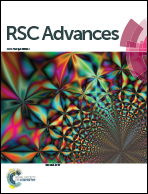A dispersed rutile-TiO2-supported Ni nanoparticle for enhanced gas production from catalytic hydrothermal gasification of glucose
Abstract
Hydrothermal gasification (HTG) is a promising technique for the utilization of wet biomass or organic wastes. This study reports a highly dispersed rutile-TiO2-supported Ni nanoparticle synthesized by a sol–gel method and its catalytic performance for gas production (H2 and CH4) from HTG of glucose as a model compound of biomass. NiTiO3 formation of the gel precursor during the calcination process demonstrated the enhanced interaction of Ni and TiO2, and highly dispersive nickel crystallites were obtained after the reduction activation. Increase of the calcination temperature decreased the catalytic activity due to the sintering of nickel crystals. The supported Ni nanoparticle greatly promoted the carbon gasification efficiency of HTG of 10 wt% glucose (glucose : Ni = 1 : 0.11) from 27.1% to 68.7% at 400 °C and from 48.2% to 96.4% at 600 °C in supercritical water. A highly active temperature region (400–500 °C) of nickel catalyzed methanation reaction for CH4 formation was particularly confirmed. As the gasification was prolonged in supercritical water, the rutile-TiO2-supported Ni nanoparticle showed stable crystalline structures and part of the deposited carbon was gasified. The regenerated catalysts also showed significant activities.


 Please wait while we load your content...
Please wait while we load your content...